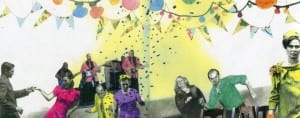
– Rhiann McLean, IRISS Associate
Last night I attended my first event of this October’s Luminate Creative Ageing Festival! The event was hosted by the law firm Anderson Strathern and Home Instead, a provider of care and support at home based in Edinburgh. There was a variety of speakers but what they all had in common was that they were using creativity to connect with people with dementia and their carers.
All of them described art and creativity as a way of establishing:
- Connection
- Identity and Memory
- Community
- Communication
- Confidence & Self Esteem
- Support Networks
Given the recent negative media exposure around the quality of support available for older people in Scotland, it was refreshing to meet people who were dedicating time and resources to building creative solutions in their community.
I was especially interested by the work done by The Elderflowers by Hearts & Minds (http://www.heartsminds.org.uk/the-elderflowers/)
The interaction that the ‘elderflowers’ have with people with dementia is meaningful precisely because it is not prescriptive. They are able to be in the moment with the person with dementia, real or imagined. This puts people with dementia in control of their environment and interaction- a big ask. I was also very pleasantly surprised to hear that these sessions are sometimes documented in case files and medical charts as part of a larger holistic support package.
These projects were mostly smaller, local, and reliant on inconsistent funding and donation models. Some of them were struggling to meet demand and felt they needed more stable investment. They were all able to evidence (through case studies and feedback) the impact that their support was having on older people and their carers. I believe that preventative programs like these are a vital part of the changing landscape of care; they reduce isolation, harness community resources and can be crucial to preventing crisis. So why is this kind of provision is so ‘bitty’ and struggling to find funding and sustainability? Do we value it less than traditional mainstream services?
I see the opportunity in these community projects- particularly when linked in with formal paid care. Do they know about each other? Can they work together? Imagine the opportunity of complementary support that included care at home and peer support in the community!
I believe that more ‘formal’ support services can learn from the fearlessness of these initiatives, and how closely they build services with the people who access them. Community projects like the ones showcased last night have the opportunity to ‘prototype’ ideas in a way that many contracted and formalised organisations may feel they cannot. They also have an open and fluid design –where the people attending are able to contribute, feed back and change the provision of support.
I suppose a lot of the progress that has to come through Reshaping Care for Older People is linking between these community, unpaid supports and ‘formal supports’ to coordinate an approach to aging that can be both preventative and responsive.
Fit for The Future aims to increase the capacity of providers to respond to Reshaping Care for Older People. Part of this will mean re-examining ‘traditional’ support, and finding a way to connect with the people who use services and respond. I believe that the Luminate festival is an excellent showcase of ways to bridge the gap between people and services and really connect meaningfully with older people.
I recommend that you have a look at what’s on locally: